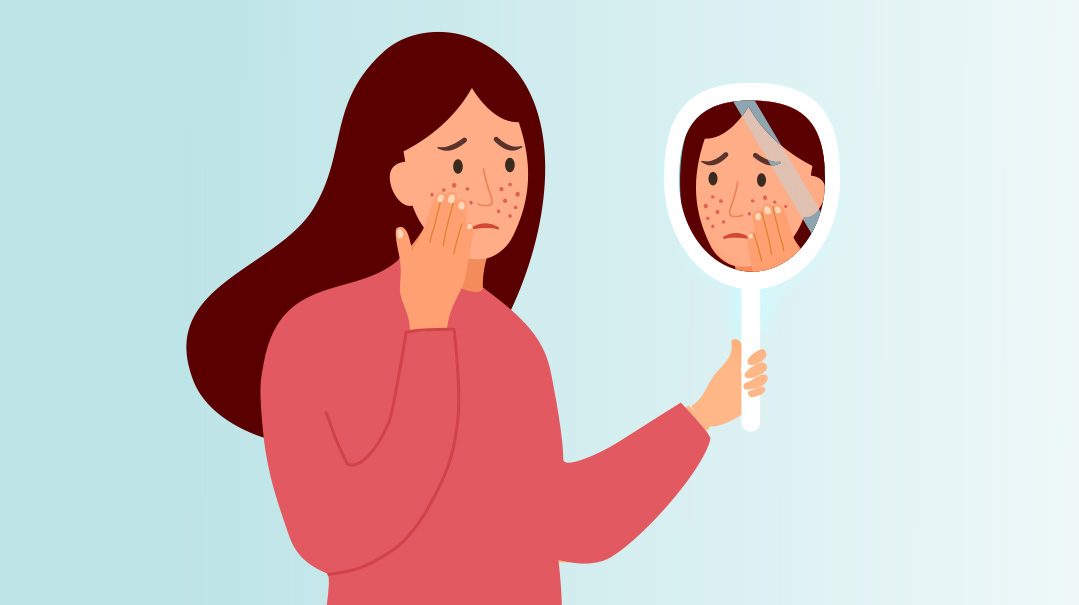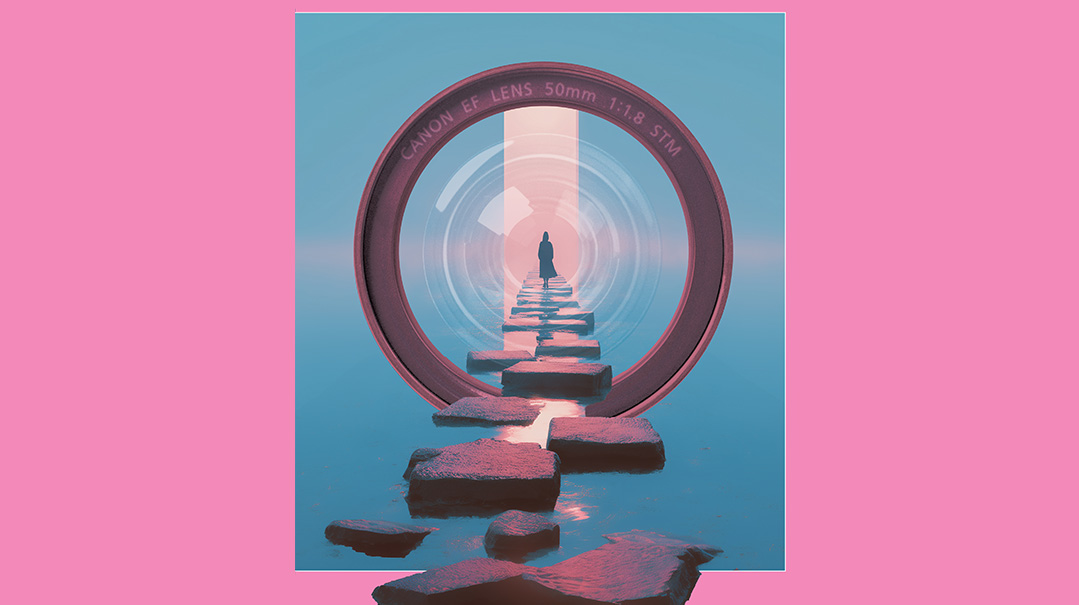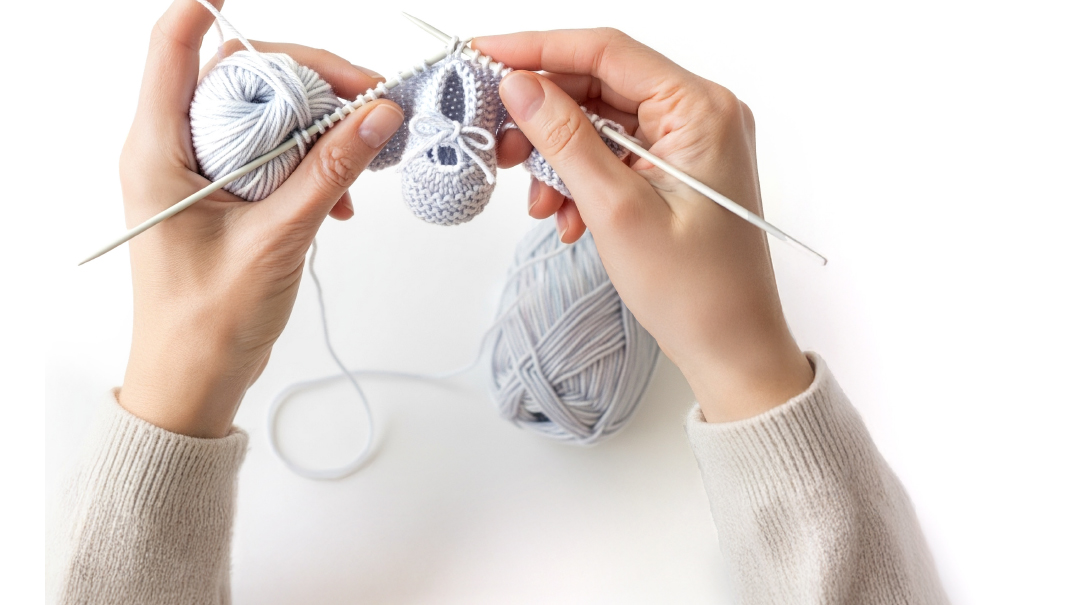Making It Clear
| June 7, 2022Acne’s not just for teens — and it’s disfiguring and debilitating

T
here’s a widespread misconception out there that acne is a teenage problem, a minor annoyance that might impact a child’s self-esteem, poor thing.
I learned firsthand that it isn’t.
I was 27, married, and a mother, when I contracted a disfiguring skin condition. When I was growing up, my skin had been normal. I had a few zits, sure, but for the most part I looked fine. My skin was clear at my wedding, and stayed okay through my first pregnancy, birth, and nursing.
But one day it wasn’t okay anymore. My hormones decided balance was boring, and clear skin was for other people. (Fertility, too, for that matter.) The cysts were painful, and my face looked awful, bad enough that I couldn’t go out in public without heavy makeup. A long Yom Tov had me hiding in my room, leaving in the middle of a seudah because I couldn’t stand having my condition on display. At a family levayah, a relative asked what was wrong with my face.
I felt hopeless and frustrated and ugly. I stopped looking at myself in the mirror, and when I inadvertently caught a glimpse, I’d be upset for hours.
Then there was the shame that came along with the condition, the insinuation from others that you haven’t tried everything or aren’t working hard enough to get rid of it. People assume you’re somehow too klutzy enough to try the treatment that worked on their great-niece’s sister-in-law. That maybe if you changed your diet, or used the right magical treatment, the acne would disappear.
But it doesn’t work that way.
I
started with the basics — over-the-counter stuff, like face washes and spot treatments, normal things you can get from CVS. Then I started doing some research.
A quick search of my Amazon history shows a baking soda scrub; a clay mask kit with cider vinegar and plastic utensils, because metal would mess with the clay’s vibrations or something; several varieties of full-coverage foundation and concealer, with one application method weirder than the next; and that rose water toner Amazonians are so obsessed with. (It made things worse, in case you were wondering.)
I went to see a dermatologist, but there was only so much he could do. At every visit, he swabbed my face with acid for a chemical peel, injected cortisone into the largest blemishes, and sent me on my merry, stinging, bleeding way.
I tried the pills and creams and chemical peels he prescribed. One pill messed with my hormonal cycle. I put my foot down after three months. Oral antibiotics helped a bit, but destroyed my digestive system. Creams accomplished more but not enough. Nowhere near enough.
I tried more over-the-counter-stuff — miracle toners and washes and masks and peels — but nothing worked. And the longer I struggled, the worse my scarring got.
That was one of the most difficult parts — looking at my face and knowing that even if the acne went away, the scarring, redness, and pitting I was developing would never disappear. And I wasn’t convinced the acne would ever go away.
I spent a fortune on makeup. I owned ten different foundations. I tried cheap options and expensive ones. (Cheap was better.) I tried primers to smooth and blur things over. (That was never going to work unless I used actual spackle.) I played with concealers and wondered why they weren’t heavier. I tried a color concealing palette, banking on the theory that the opposite colors cancel each other out. It stood to reason that smearing green paste on my face would make all the red bumps disappear. (It turned my skin gray, and no amount of foundation quite erased the zombie effect.)
I dabbled in setting powders — loose, pressed, sheer, tinted, you name it. I tried beauty blenders and silicone dabbers and kabuki brushes, hoping that the right application technique would finally give me the flawless canvas I so desperately wanted.
Every foundation I tried split as soon as I applied it, leaving me with patchy coverage and limited staying power. At some point, I realized this was due to one of my creams, and switched brands, which helped a bit. A bit, but not nearly enough.
E
ventually, out of the blue, I found out that I was expecting. Slowly, my skin improved. After my baby was born, I was able to try a powerful treatment that worked miracles on my acne and scarring.
My skin routine is simpler now: face wash, one cream, a retinol serum, and sunscreen in the morning. My face and I have come to a truce, where I won’t antagonize it with makeup if it doesn’t give me breakouts to cover up.
It works. My makeup sits mostly unused on my dresser, and the acne is gone.
The scarring is fading, though it will never disappear. I don’t hate my face anymore. It’s a rather nice face, honestly.
It’s easy to dismiss acne as trivial. For some reason, we consider it shameful — like it’s the sufferers’ fault somehow. If only they pulled themselves together, they’d have spotless complexions. They must not care about how they look. (Or, apparently, about being in pain — having multiple swollen sores on your face is extremely uncomfortable, especially when you’re trying to sleep.)
I’m here to refute that notion. I tried everything. I kept up my skin care routine religiously, bought all the right products, did my own research, and sought medical advice.
I was lucky; eventually, I found a solution. It’s unlikely the acne will return, but I live in fear. And I’m left with scarring on my cheeks — general redness, spots of discoloration, and pitting. It will probably improve over time, but it can take years.
R
ecently, my dermatologist suggested microneedling to treat my scarring. It wouldn’t be covered by insurance, and it would total around $800. Truthfully, for a treatment with permanent benefits, that’s cheap. I even had the cash available.
But all I could muster in response to the idea was, “Eh…”
I simply didn’t care enough to dedicate that percentage of my income to my face. If I were a millionaire and this were pocket change, I’d probably get around to it, but it’s just not that important to me. Is it just that things are so much better than they were? Have I grown to value myself more than my appearance?
I don’t know. I’m still terrified of the acne coming back. But to me, this was a hopeful sign.
Acne is awful. But you are living, you are loving, and you are loved.
Maybe that can be enough.
If you’re suffering from acne to any degree, know this: This isn’t your fault. You are doing enough. Your pain is real. And one day, it will get better.
It’s okay to reject the cliché, “You’re beautiful no matter what; your value doesn’t come from physical beauty.” That simply doesn’t ring true in the world we live in.
But you don’t need to be beautiful. You deserve beauty, and you will feel pretty again one day — either when your skin improves, or when you can internalize your own worth. But you don’t owe beauty to anyone, and you are worthwhile simply because G-d placed you in This World for a reason.
It’s painful when your external appearance doesn’t reflect your internal reality. Do whatever you need to feel confident. Buy the really good makeup, if you want. Use the really powerful medicine, if you’re comfortable with it. Wear sunscreen, no matter what.
You’ll get through this.
And maybe, if you’re lucky, you’ll emerge with a clearer view of reality. You’ll be a little less confused by the Olam Hasheker, a little more aware of the gorgeous souls around you.
Medical Options
My acne was hormonal — if you break out mostly on your jawline and cheeks, yours might be, too. Obviously, this makes a difference in treatment protocols. These are the various treatments I’ve tried. I’m not a medical professional; I’m simply sharing my personal experience.
Spironolactone – Used to lower levels of testosterone and other androgens (male hormones). It’s a common treatment for acne and facial hair overgrowth (hirsutism) caused by PCOS (polycystic ovary syndrome). Spironolactone seemed to help the acne, but it messed with my hormone cycle, so I stopped it after a few months.
Doxycycline – An antibiotic used to control the bacteria that causes acne. I found it somewhat helpful. Of course, it’s never ideal to take antibiotics over a long period of time. Doxycycline increases sun sensitivity, in addition to a long list of potential side effects. It’s also effective only as long as you take it, and can be dangerous during pregnancy. For me, personally, it caused stomach upset as well.
Isotretinoin (Often called Accutane, though it’s no longer available under that name– This was the single most effective treatment I tried. Isotretinoin is quite powerful. It’s a super concentrated form of Vitamin A and causes severe dryness and peeling of the skin. People taking Isotretinoin need to be vigilant with sunscreen, too, since it increases the risk of sunburn.
It’s a last-resort acne treatment for women of childbearing age, since it causes severe birth defects if taken during pregnancy. Women capable of pregnancy need to be enrolled in the iPledge program, which includes monthly fasting blood tests in addition to specific precautions related to pregnancy. To further complicate the matter, it isn’t available from regular pharmacies. I used a specialty pharmacy that delivered, but required ID at every delivery.
To be honest, iPledge is a pain in the neck, especially for married women. But Accutane works. It not only eliminates acne long term, it also provides major improvement in scarring. While it sounds like a scary medication, most people tolerate it well, and it works. If you have a teenage daughter struggling with acne who isn’t planning to get married in the next six months, it’s a wonderful option. And it’s much easier and safer for a teen to take it than a married woman.
Hormone pills (specifically progestin/estrogen combinations) – If your acne is hormonal, then controlling those hormones will be very helpful in keeping it under control. But for halachic reasons, these medications will not be an option for everyone.
Cortisone injections – This is a targeted treatment in which a dermatologist injects a corticosteroid directly into an acne cyst. It’s a wonderful quick fix if you’re in a lot of pain or have a simchah to attend. (My dermatologist also did it at every monthly visit). The needle is very thin, but it’s being inserted into a swollen, painful area, so this treatment is not painless. I’d occasionally wince, but found the discomfort brief and manageable, and my face would hurt less for the next few days, so it was worth it.
Chemical peels – A dermatologist swabs the skin with glycolic acid. My doctor started at a lower concentration and worked his way up each month to make sure I tolerated it well. I felt some stinging for a few minutes afterwards, and would experience some dryness, redness, and irritation for a few days. Also, I’d end up going to work with red skin covered by a frost of sloughing skin cells and acid, but it never looked bad enough for anyone to comment.
Retinoids – These creams boost skin cell turnover, which helps keep pores from clogging and reduces scarring. They’re not effective spot treatments, since benefits accumulate over time. Adapelene (Differen) is the most commonly prescribed. It’s available over-the-counter, but some insurances will cover it, too. Retinoids make skin more susceptible to sun damage, so apply them at night and be sure to wear sunscreen. I still use retinoids to reduce scarring.
Azelaic acid (Finacea) – This cream is antimicrobial and anti-inflammatory, so it helps control acne-causing bacteria and reduce redness and swelling. I’d use Azelaic acid in the morning, but the version I was prescribed made my foundation split, which is a problem for a self-conscious acne sufferer. My insurance covered it, but it’s also available over the counter, and I found another brand that didn’t mess with my makeup.
Over-the-Counter Route
There are lots of over-the-counter treatments available for acne. Check with your dermatologist before combining these with each other or the treatments above to avoid irritating your skin.
Note that there will always be luxury and drugstore brands available for all of these products. I’m a drugstore gal, so those are the sources I provide here.
Azelaic acid – You can get it prescribed (see above) but I prefer one produced by the Ordinary, available online and in stores like Ulta and Sephora.
Retinol – A super-trendy skin care ingredient. It’s available with a prescription (see above) but I dislike the texture of Differin gel — I find it a bit stiff and tacky. I very much like CeraVe’s Resurfacing Retinol Serum, which softens my skin and doesn’t leave a residue. It’s available in any drugstore.
Benzoyl peroxide – You might remember this as Clearasil. It’s great for a spot treatment or a daily preventative, and is available as a cream or face wash. Benzoyl peroxide will bleach fabrics, including towels and pillowcases. I didn’t use it because I hated ruining my linens, but you can just use cheap towels and pillow covers if you or your teen want to go this route.
Salicylic acid – another great spot treatment and general preventative, also available in cream and face wash. I like Neutrogena’s range, but there are many good options available.
Cortisone cream – reduces redness and inflammation. You don’t want to overuse any steroid, but it’s a nice option to have available for particularly painful blemishes.
Glycolic acid peels – Similar to what the dermatologist uses for chemical peels, but significantly weaker, so you can use them at home and a bit more frequently. Once or twice a week is plenty, though — don’t overdo it. You’ll find this in any drugstore. Pixi and the Ordinary are good options, but any popular skin care brand is fine. It will sting if your skin is irritated or broken.
Hydrocolloid patches – Once used mostly to protect blisters, hydrocolloid patches are one of my favorite secret weapons against acne. Hydrocolloid absorbs moisture, and it seems to suck the gunk out of zits and absorb oil from the surrounding skin. Mostly, though, I love these little guys because they stop me from picking, and I don’t notice them while they’re on. I’ll just slap a patch on any burgeoning acne volcanos and go to sleep — it always looks much better in the morning. The patches I use from Alba Botanica are very discreet, but if you’re a lighthearted soul, Starface Hydro-Stars are brightly colored, star-shaped stickers that do the exact same thing. Some hydrocolloid patches also contain bonus ingredients like tea-tree oil or salicylic acid.
Niacinamide – Another super-stylish ingredient, it reduces inflammation and controls oil production. It’s available everywhere, often blended with other treatments, like the CeraVe retinol above.
Aquaphor – not an acne treatment, but if you’re taking Accutane or using the more heavy-duty topical treatments, you’ll want a really powerful moisturizer. Yes, I’m recommending you use it on your actual face.
Sunscreen – I use one with a moisturizer, because if I need to apply two products, I won’t use either. I love CeraVe’s moisturizing lotion with SPF, but any reputable brand is fine.
Gentle face wash – if you’re a teen with normal acne, you might like using a medicated wash to save yourself a step in your nighttime routine. (See benzoyl peroxide and salicylic acid, above.) But if you’re using the big guns to treat severe acne, you need a very gentle face wash for your poor, abused skin. I currently use Cetaphil’s face wash, but I have my eye on CeraVe, too.
Oil-based cleanser – This sounds counterintuitive, but using an oil- based cleanser followed by a foaming wash is really effective at removing makeup and oil buildup without stripping skin of its natural moisture. I really like the Rice Water Bright set from Amazon — it includes both face washes — but I’ve had success with Burt’s Bees Oil Wash or Neutrogena Ultra Light Facial Cleansing Oil, both followed by Neutrogena Fresh Foaming Cleanser. I only double cleanse when I’m wearing makeup (which isn’t often) and will usually follow up with micellar water (mine is from Garnier) to eliminate the last few traces of mascara.
Cosmetics for Cover
Here are my drugstore makeup favorites for hiding acne:
e.l.f. 16 HR Camo Concealer – full coverage and long-wear. A godsend for camouflaging acne. Officially, you’re supposed to apply foundation before concealer, so you only cover what the foundation can’t, but for special occasions, I’d use concealer first for better blending. I’ve also heard good things about NYX’s Can’t Stop Won’t Stop concealer.
Revlon Colorstay Makeup for Combination/Oily Skin – long- wearing, nice coverage, and cheap enough that I was happy to wear it every day.
Revlon Colorstay Full Cover Foundation – Super-full coverage. Think of it as a concealer for your whole face. I used this when I needed the extra bit of confidence.
L’Oreal Infallible Pro-Matte Foundation – Another good option for every day, with a nice matte finish.
Coty Airspun Face Powder – Locks everything in place and blurs imperfections. This is a loose powder, so it does make a bit of a mess, but it’s sheer enough that you don’t need to worry about shade matching. Try a pressed powder if you need something neater, but it won’t have quite the same effect.
(Originally featured in Family First, Issue 796)
Oops! We could not locate your form.







